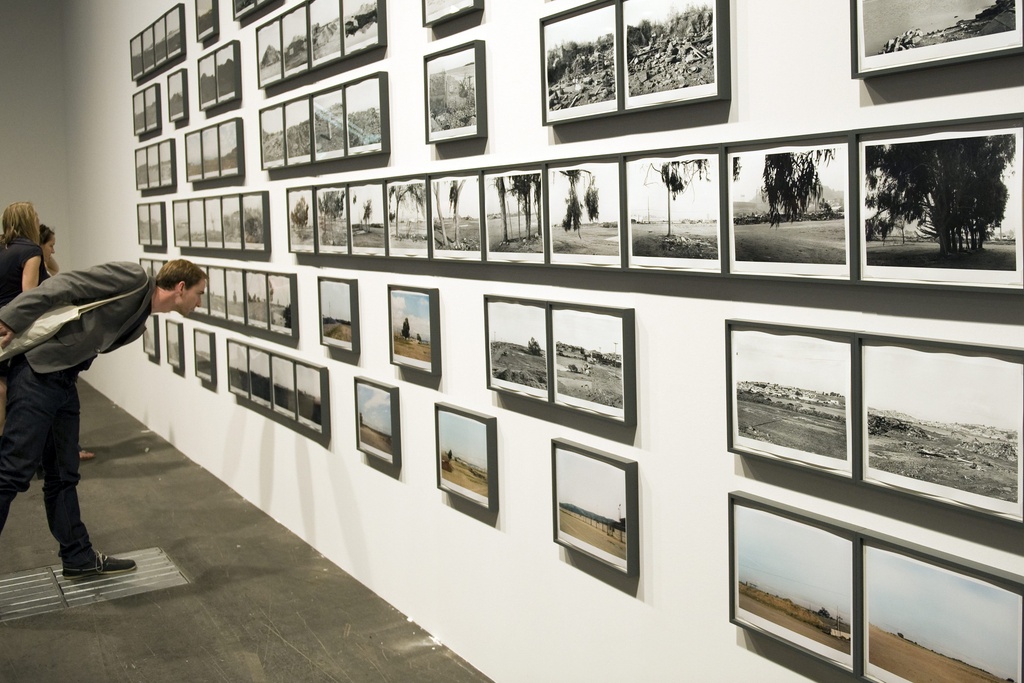
Basel abuzz as annual art-fest opens doors

The three big As - art collectors, artists and A-list VIPs – alongside tens of thousands of curious modern art fans are gathered in Basel for the annual Art Basel.
The northwestern Swiss city is the host for the world’s top fair for modern and contemporary works, taking place for the 42nd time.
The art-fest brings together 300 leading galleries from all over the world and 2,500 artists, ranging from the great masters of modern art to the latest generation of emerging stars.
The privileged few who actually manage to exhibit their work pay a high price. A small stand and five days’ expenses can reportedly set you back SFr100,000 ($117,787) and sales are not guaranteed.
So is it all worth it? Yes, definitely, says Nicolas Galley, director of the new “Executive Master in Arts Administration” postgraduate diploma course at Zurich University.
“The galleries may not be able to present young unknown artists, who appear mostly in United States fairs, but in terms of image, meetings and general visibility, Basel has a great deal to offer,” he told swissinfo.ch.
“The quality of the organisation and the selection of work on offer put Art Basel well above all other fairs. The events sector, such as Art Unlimited, is also highly developed, and there is a huge programme with debates and films. And we shouldn’t forget the parallel fair “Liste 16” [of young galleries and artists]. This concentration of art really is unique.”
According to Galley, artists who avoided Art Basel in the 1980s and 90s are now starting to exhibit.
“The institutional art world and the commercial market have moved closer together and people have realised that the market hasn’t necessarily ruined artists, even the conceptual ones who are not easy to sell such as Swiss artist Thomas Hirschhorn,” he added.
Extreme opacity
But the art market is not without its critics. Some observers, like Sébastien Guex, a professor of contemporary history at Lausanne University, denounce its extreme opacity.
“There’s a real code of silence as most people involved are not subject to the same kind of accounting as banks or the big auction houses, which are listed on the stock market and bound by transparency rules,” said the professor, who has analysed the art market and banks.
Guex compares the worlds of art and sport, “both hungry for records with an interest in creating the impression of a constant increase in value without ever giving any overall figures”.
Over the past 20 years the black market for art is estimated to have been worth between SFr2-10 billion a year for a global market worth SFr15-20 billion, says the art expert.
This tradition for discretion stems from “the cult of banking secrecy linked to wealth management and private banking”, said Guex.
It can also be explained by tax issues and the way the art market operates, as art is at the centre of an extremely speculative activity with a symbolic capital whose value is impossible to calculate, he added.
Passionate art fans
While Guex is convinced the art and financial markets have been built by huge global fortunes, Galley stresses the importance of modest art fans.
“It’s true that the global market consists of 500-1,000 major actors, but lots of collectors come to Basel with a budget of just a few thousand Swiss francs and lots of passion,” he commented.
For Vincenzo Abate, creator of the PAH Project art platform in Fribourg, the annual pilgrimage to Basel is one not to be missed.
“I’m interested both as an artist and as a promoter because for me the more people view the work the better,” he noted.
“It’s true the fair stinks of money, but after all people have always bought works of art for their own private use. The most important thing is that as many people as possible can see your work,” he said.
The 33-year-old artist-gallery owner dreams of one day having his own stand at Art Basel.
“My exhibition space is a different kind of place and my attitude is probably different too. Maybe I would be more at home in the parallel fair, the Liste 16, but I don’t really mind which one really.”
Art Basel, in its 42nd edition, runs from June 15-19, 2010.
This year Art Basel features 300 galleries (selected from 1,000 applicants) from 35 countries in North America, Latin America, Europe, Asia and Africa. 20th and 21st century works from more than 2,500 artists are on show.
The exhibition includes paintings, sculptures, drawings, installations, photographs and videos.
It is said to be the premier event of its kind and allows art lovers to rub shoulders with the cognoscenti and gain an overview of the art market. A record 62,500 people visited last year.
Galleries’ provenance – the top three: United States (73), Germany (50) and Switzerland (32).
(translated from French by Simon Bradley)

In compliance with the JTI standards
More: SWI swissinfo.ch certified by the Journalism Trust Initiative
















![The four-metre-long painting "Sonntag der Bergbauern" [Sunday of the Mountain Farmers, 1923-24/26] had to be removed by a crane from the German Chancellery in Berlin for the exhibition in Bern.](https://www.swissinfo.ch/content/wp-content/uploads/sites/13/2025/12/01_Pressebild_KirchnerxKirchner.jpg?ver=cb688ed5)














You can find an overview of ongoing debates with our journalists here . Please join us!
If you want to start a conversation about a topic raised in this article or want to report factual errors, email us at english@swissinfo.ch.